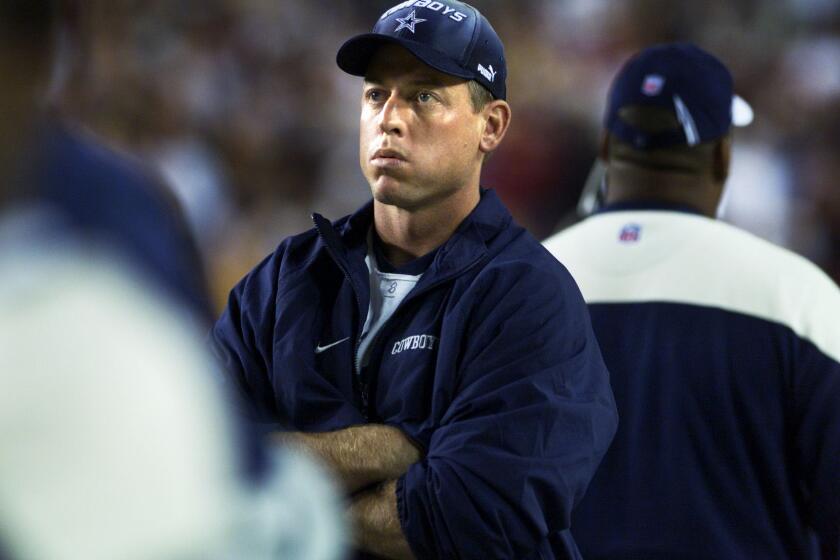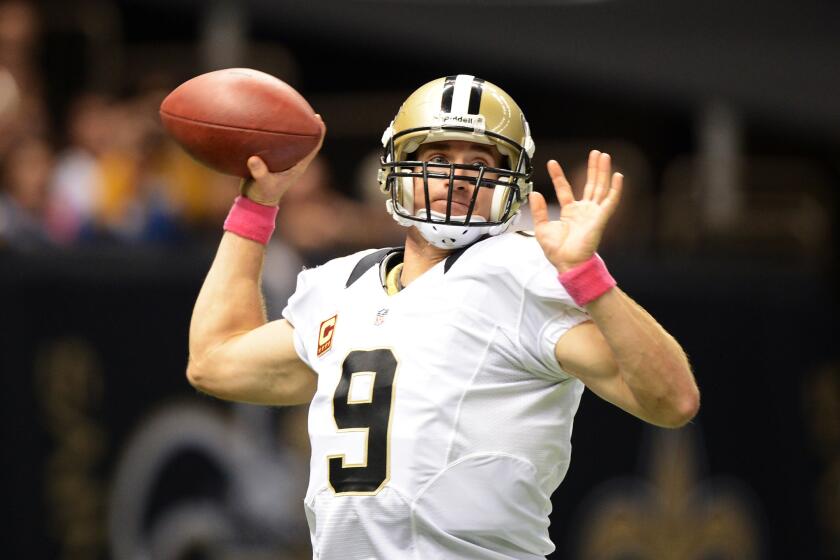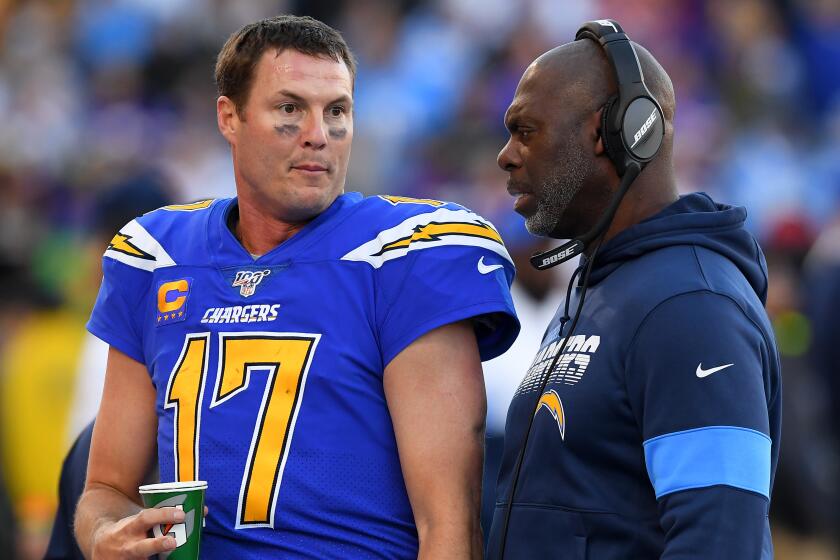What makes New Orleans Saints quarterback Drew Brees so great? Experts explain
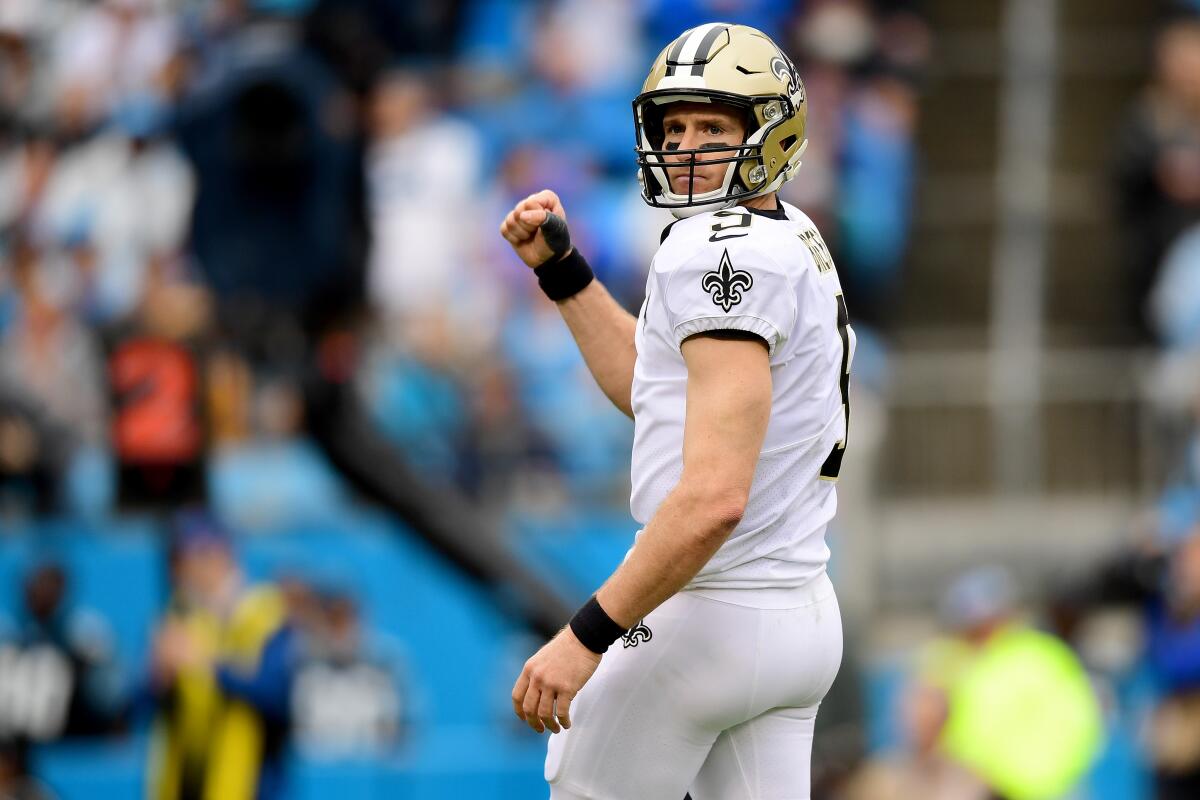
- Share via
NEW ORLEANS — Drew Brees keeps stacking records. The New Orleans Saints quarterback holds the NFL career marks for completions, completion percentage, passing yards and passing touchdowns.
He heads into a wild-card showdown Sunday against the Minnesota Vikings with 16 touchdowns and zero interceptions in his last five games. He has completed a staggering 74.3% of his throws this season, which is best in the NFL and just a wisp below his NFL-record 74.4% of last season.
To get a perspective on what sets Brees apart, aside from the numbers, the Los Angeles Times talked to 10 quarterback experts — four of them in the Pro Football Hall of Fame — regarding what they appreciate most about the 40-year-old player who has turned this city into Drew Orleans.
The panel: former NFL quarterbacks Rich Gannon, Carson Palmer, Archie Manning, Matt Hasselbeck and Trent Dilfer, plus Hall of Famers Steve Young, Kurt Warner, Troy Aikman and Fran Tarkenton; and Rick Neuheisel, former UCLA quarterback and coach, and onetime offensive coordinator of the Baltimore Ravens. Saints coach Sean Payton also weighed in, as did Brees, in response to some of the observations.
The topics were varied, ranging from Brees’ otherworldly accuracy, to his obsessive competitiveness, from the way he and Payton click, to how the Louisiana State offense and Heisman Trophy-winning quarterback Joe Burrow have mimicked what the Saints do.
Tom Brady leaving the Patriots might not sound so far-fetched when you hear about how close Troy Aikman got to playing for the Chargers and Dolphins.
The story is a series of interviews, stitched into a conversation aimed at further shedding light on how Brees is different:
ACCURACY
MANNING: The thing that sets him apart is his accuracy. I saw [Green Bay’s] Aaron Rodgers had 16 overthrows last week. Drew hasn’t had 16 overthrows in the last five years. He’ll make throws that in my day looked like a bad throw that the receiver made a super adjustment on. That’s what it would have been 25 years ago. But now it’s part of the package. Those are the accurate throws that aren’t to the front of a receiver, but to a covered receiver, where the defender can’t knock it down or catch it but the receiver can.
HASSELBECK: When I got into the NFL, your goal, like [former Green Bay assistants] Mike McCarthy or Andy Reid said to me, “The Joe Montana goal every year under Bill Walsh was 65% completions.” That was almost unattainable, but it was a goal to shoot for. Dude, this month Brees is at 75%. I mean, it’s nonsense. But it’s not like it’s Charlie Checkdown, dink and dunk. It’s still [Saints receiver] Michael Thomas having a record-breaking year.
NEUHEISEL: He has invented throwing people open. The back-shoulder throw should be called the Brees Shoulder.
BREES: When you look at a receiver running a route, you say, “Is he open?” And maybe our interpretation of “Is he open” is different than other people’s. I feel like there’s a place where I can throw the ball where I can get it and the other guy can’t, and if I trust that guy, there’s a good chance I’m throwing it.
The No. 6 seed Minnesota Vikings visit the No. 3 seed New Orleans Saints for an NFC wild-card playoff game. Sam Farmer predicts the winner.
QUICK RELEASE
HASSELBECK: On average, Drew Brees is getting the ball out of his hands in 2.57 seconds this year. That’s the second-fastest in the NFL. That to me is basically throwing the ball on time, more being a point guard, not necessarily looking off every safety and heaving it down the field.
WARNER: I just love to watch how he can process it and get through his progressions, get to guys that a lot of people might look at it and say, “It’s his checkdown? Why’d he go to his checkdown so fast?” It’s because he understood what that defense was doing, what they were taking away, what they were voiding on the field, which allows him to get to that guy.
PAYTON: One of his strengths would be processing. It’s the hardest thing for us to evaluate when we’re evaluating a college quarterback: How quickly are they processing the information relative to their progression? It happens very fast for him. He has that vision. He can see it, then set his feet, and throw an accurate ball. He’s a tremendous foot athlete, and that also plays into it.
DECEPTION
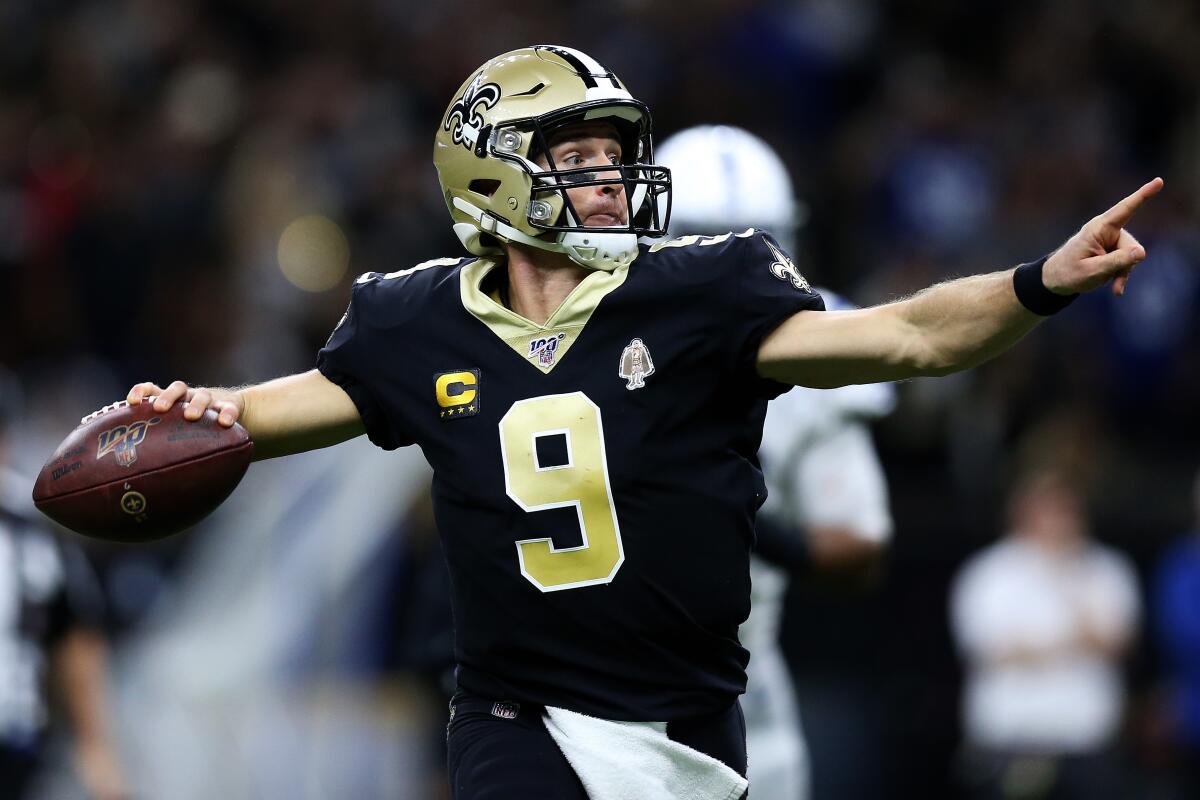
YOUNG: Drew Brees is a liar. The whole thing about quarterbacks is not to show you what they’re going to do. Drew’s a master at lying with his eyes, lying with his shoulders. He contorts his whole body to move safeties and make them believe he’s doing something that he’s not going to do. It like a magic act.
BREES: About midway through my career here, we were in practice one day and we had a great defense. I was used to moving guys with my eyes all the time. I remember in the middle of a practice, one of them yelled, “Don’t look at his eyes. Look at his shoulders. His shoulders are going to tell you where he’s throwing it.” So I was like, “All right.” So next time out, this guy is where I want to throw the ball, so I turn my shoulders away from him to move the defender, and then I come back and throw it to the receiver. The defensive guys look at the coach and at the sideline and they’re like, “What now?” And I’m like, “Got ‘em.”
COMPETITIVENESS
PALMER: Drew and I were neighbors in San Diego, and we used to train all offseason together. He was so over-the-top competitive. We would jog from drill to drill, and he would have to be first. After a while it was, “All right, dude, just go.” He couldn’t turn it off. We would finish every workout with little agility games like catching cards. You’d throw playing cards in the air and catch them with one hand. … Your mind is exhausted, your body’s exhausted, and Drew just can’t turn it off. As a peer and a competitor, I was in awe. But his competitiveness got to the point where it can be annoying.
PRACTICE, PRACTICE, PRACTICE
AIKMAN: Whatever he does, however he fine tunes for games, it’s the same every week. I think those routines are important. We’ve gone to visit him on a Friday for production meetings — this is every time — and [the Saints] will say, “Hey, we’re sorry. Drew’s getting a massage,” or, “He’s in treatment, then he’ll be in.” He’s always on the same time frame.
Carson Palmer, who won the 2002 Heisman Trophy with USC and played 15 years in the NFL, is now living a quiet life in Idaho with his wife and kids.
TARKENTON: It starts when you get out of bed. You play the game in your head all the time. All afternoon. All night. Every day, every week, you’re thinking. Because you’ve got so much information to process. You’ve got to have it in your mind so it’s automatic. That’s why only a few quarterbacks make it.
PALMER: He’s always hyper-focused as soon as the offseason would start about what to get better at. It’s like he already knew, like he already planned it out in Week 9: “All right, I didn’t get really good at this this year. I need to spend my offseason on this.” Most guys like myself would go back and watch the whole season again, and then a month or two into the offseason I’d go, “Oh, man, I really did a bad job at my play-action run fakes,” or whatever. Drew always had a plan.
BREES: I just wanted to be very purposeful with everything I was doing. I didn’t want to work out just to work out. If I’m training, I’m training for something with a purpose. What am I out here doing? What am I focused on? Because then there’s that true feeling like, man, I’m getting better at something.
STRENGTH TRAINING
GANNON: He’s strong — I mean really strong — in his legs and his core. People don’t talk about where he generates a lot of the torque and his velocity on his throws. Everybody says, “He’s got a strong arm.” But there’s a lot more that goes into throwing the ball the way he does. He’s got a really strong lower half of his body.
BREES: That’s where you generate power. It’s ground-force production, torque, and then functional strength. One of my mentors, Tom House, taught me that. A lot of quarterbacks, they throw but they just don’t know why. It all times up, it works for them, but they just don’t know why. Tom House has helped me understand the why.
The Chargers need to improve, but moving on from Philip Rivers might not be the answer. Here are four tactics they can deploy to be better in 2020.
SOMETHING TO PROVE
MANNING: He’s smart, got a great work ethic, but he’s had a chip on his shoulder. I met him when he was in high school at a little banquet in Texas. I said, “Where are you going?” and he said Purdue. This is nothing against Purdue, but I’m thinking, “Why aren’t you going to Texas or Texas A&M?” I didn’t ask him, but I think the answer was they didn’t offer him.
BREES: No [scholarship offers from] Texas schools. None. It’s not a bitterness of any kind because the best thing that happened to me was being able to go to Purdue, playing in the spread offense where I can throw it 50 times a game. You talk about developing a passing game as a quarterback. No better way to do it. You’re thrown in the fire, too. I didn’t come from that style of offense in high school, so it was a big learning curve. ... But I’m leaving my friends, I’m going to this foreign land, the Midwest. Six feet of snow on the ground. Couldn’t see the buildings when I’m going on my visit. I’m thinking, “What am I doing?”
THAT LOOKS FAMILIAR
NEUHEISEL: The marriage with him and Sean Payton has been hugely advantageous. All you have to do to know that is watch [LSU quarterback] Joe Burrow. ... Joe Burrow’s offense is basically from Sean Payton. [LSU passing game coordinator] Joe Brady was a quality-control guy from the Saints. He brought the New Orleans formations. He brought the five-man protection, and don’t think that Brees and Payton don’t collaborate on that.
BREES: I’ll see concepts that I recognize. I’ll see them check to things, and I’ll call it before it happens. Listen, they’re doing all the [run-pass option] stuff that we don’t necessarily do. But that’s something that Joe Brady had in his background prior to coming here. … Joe Burrow’s efficiency is what impresses me. He can buy time with his legs. He takes off and scrambles six, seven, eight times a game for 60 yards. So he’s making plays with his legs that make him different than your typical pocket passer.
THE WHOLE PACKAGE
DILFER: There are 15,000 starting quarterbacks in high school football right now. There are 686 college starting quarterbacks. There are 32 starting NFL quarterbacks. Now, extrapolate that out with all the quarterback coaches, offensive coordinators and head coaches. They all have an opinion of what it takes to be great as a quarterback. Drew Brees is the only one who checks the box on all of them.
More to Read
Go beyond the scoreboard
Get the latest on L.A.'s teams in the daily Sports Report newsletter.
You may occasionally receive promotional content from the Los Angeles Times.

